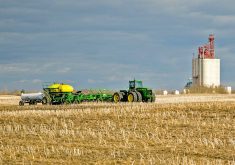The Western Grains Research Foundation (WGRF) will now directly manage publicly funded wheat breeding in Western Canada thanks to the creation of the Canadian Wheat Breeding Cluster, says foundation vice-chair and Dauphinarea farmer Don Dewar.
The federal government is contributing more than $8 million to the cluster to go with wheat checkoff money collected by the WGRF, David Anderson, parliamentary secretary to the Minister of Natural Resources and for the Canadian Wheat Board, said Sept. 15 a news conference in Saskatoon.
“It’s a whole new direction for the WGRF,” Dewar said in an interview. “We’re now in the breeding business you might say, whereas we were in the granting business before. So it’s a challenge and it’s going to be interesting.”
Read Also

Manitoba boosts stake in cereals centre to $23.5 million
Premier Wab Kinew said the additional project funds will help ‘Trump-proof’ the provincial economy.
Instead of spending the money itself, the federal government is transferring it to the WGRF, which will direct and monitor how it’s spent by Agriculture and Agri- Food Canada at its three cereal research centres – Winnipeg, Swift Current and Lethbridge – as well as by the Universities of Saskatchewan (Crop Development Centre) University of Manitoba and the University of Alberta and Alberta Agriculture and Rural Development.
The WGRF is in a good position to direct wheat breeding given its board of directors represents most of the farm and commodity groups in the West, said Dewar, the Keystone Agricultural Producers’ representative.
“The idea of the cluster is to put the Western Grains Research Foundation in a even more central position in terms of working with that cluster of organizations,” WGRF acting executive director Terry Scott said
“This money allows us to do what we’ve been doing, plus allows us to expand what we’ve been doing so it’s quite positive,” he said.
And there’s more money coming from Ottawa. The WGRF is negotiating a new five-year research agreement with AAFC. According to Scott the federal contribution will be significantly higher than the past agreement.
“The $8 million (just announced) will be the minor part of the whole picture,” he said.
In addition, the federal government is investing up to $2.8 million under the Developing Innovative Agri-Products (DIAP) initiative for barley breeding and related research, Anderson said. Along with the WGRF, the project pulls together partners with a direct interest in barley research, including the Canadian Wheat Board, the Alberta Barley Commission, the Brewing and Malting Barley Research Institute and Rahr Malting Canada Ltd.
Demand for high quality Canadian malt, malt products, bioproducts and healthy food is rising, and producers need new barley varieties to compete in the marketplace. The WGRF will work with Agriculture Canada researchers to enhance barley quality.
The Grain Growers of Canada (GGC) welcomed the news of increased federal funding for wheat and barley breeding.
“It’s a step down the right road to get back to where we were,” GGC executive director Richard Phillips said.
But Phillips said the GGC will continue to push Ottawa to restore agricultural research spending to 1994 levels, adjusted for inflation. That means increasing the research budget by $26 million a year for the next 10 years to a total of more than $560 million – double today’s spending.
———
“Thismoneyallowsustodowhatwe’ve beendoing,plusallowsustoexpandwhat we’vebeendoingsoit’squitepositive.”
– TERRY SCOTT















